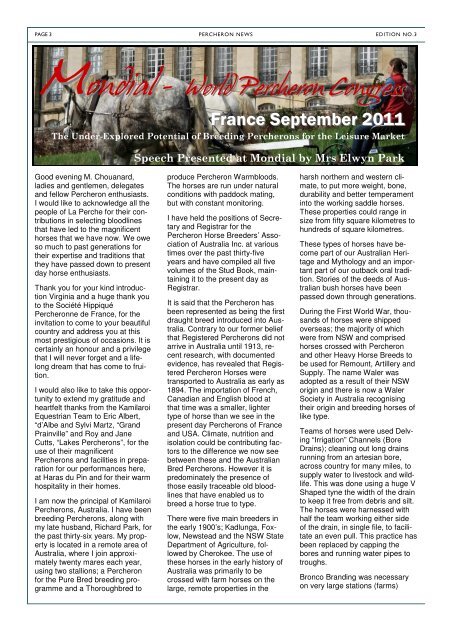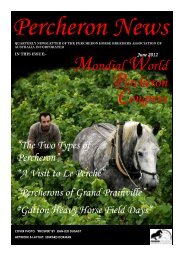to view the newsletter - Percheron Horse Breeders Association of ...
to view the newsletter - Percheron Horse Breeders Association of ...
to view the newsletter - Percheron Horse Breeders Association of ...
Create successful ePaper yourself
Turn your PDF publications into a flip-book with our unique Google optimized e-Paper software.
PAGE 3 PERCHERON NEWS EDITION NO.3<br />
Mondial ondial -<br />
Good evening M. Chouanard,<br />
ladies and gentlemen, delegates<br />
and fellow <strong>Percheron</strong> enthusiasts.<br />
I would like <strong>to</strong> acknowledge all <strong>the</strong><br />
people <strong>of</strong> La Perche for <strong>the</strong>ir contributions<br />
in selecting bloodlines<br />
that have led <strong>to</strong> <strong>the</strong> magnificent<br />
horses that we have now. We owe<br />
so much <strong>to</strong> past generations for<br />
<strong>the</strong>ir expertise and traditions that<br />
<strong>the</strong>y have passed down <strong>to</strong> present<br />
day horse enthusiasts.<br />
Thank you for your kind introduction<br />
Virginia and a huge thank you<br />
<strong>to</strong> <strong>the</strong> Société Hippiqué<br />
<strong>Percheron</strong>ne de France, for <strong>the</strong><br />
invitation <strong>to</strong> come <strong>to</strong> your beautiful<br />
country and address you at this<br />
most prestigious <strong>of</strong> occasions. It is<br />
certainly an honour and a privilege<br />
that I will never forget and a lifelong<br />
dream that has come <strong>to</strong> fruition.<br />
I would also like <strong>to</strong> take this opportunity<br />
<strong>to</strong> extend my gratitude and<br />
heartfelt thanks from <strong>the</strong> Kamilaroi<br />
Equestrian Team <strong>to</strong> Eric Albert,<br />
“d’Albe and Sylvi Martz, “Grand<br />
Prainville” and Roy and Jane<br />
Cutts, “Lakes <strong>Percheron</strong>s”, for <strong>the</strong><br />
use <strong>of</strong> <strong>the</strong>ir magnificent<br />
<strong>Percheron</strong>s and facilities in preparation<br />
for our performances here,<br />
at Haras du Pin and for <strong>the</strong>ir warm<br />
hospitality in <strong>the</strong>ir homes.<br />
I am now <strong>the</strong> principal <strong>of</strong> Kamilaroi<br />
<strong>Percheron</strong>s, Australia. I have been<br />
breeding <strong>Percheron</strong>s, along with<br />
my late husband, Richard Park, for<br />
<strong>the</strong> past thirty-six years. My property<br />
is located in a remote area <strong>of</strong><br />
Australia, where I join approximately<br />
twenty mares each year,<br />
using two stallions; a <strong>Percheron</strong><br />
for <strong>the</strong> Pure Bred breeding programme<br />
and a Thoroughbred <strong>to</strong><br />
World <strong>Percheron</strong> Congress<br />
France September 2011<br />
The Under-Explored Potential <strong>of</strong> Breeding <strong>Percheron</strong>s for <strong>the</strong> Leisure Market<br />
Speech Presented at Mondial by Mrs Elwyn Park<br />
produce <strong>Percheron</strong> Warmbloods.<br />
The horses are run under natural<br />
conditions with paddock mating,<br />
but with constant moni<strong>to</strong>ring.<br />
I have held <strong>the</strong> positions <strong>of</strong> Secretary<br />
and Registrar for <strong>the</strong><br />
<strong>Percheron</strong> <strong>Horse</strong> <strong>Breeders</strong>’ <strong>Association</strong><br />
<strong>of</strong> Australia Inc. at various<br />
times over <strong>the</strong> past thirty-five<br />
years and have compiled all five<br />
volumes <strong>of</strong> <strong>the</strong> Stud Book, maintaining<br />
it <strong>to</strong> <strong>the</strong> present day as<br />
Registrar.<br />
It is said that <strong>the</strong> <strong>Percheron</strong> has<br />
been represented as being <strong>the</strong> first<br />
draught breed introduced in<strong>to</strong> Australia.<br />
Contrary <strong>to</strong> our former belief<br />
that Registered <strong>Percheron</strong>s did not<br />
arrive in Australia until 1913, recent<br />
research, with documented<br />
evidence, has revealed that Registered<br />
<strong>Percheron</strong> <strong>Horse</strong>s were<br />
transported <strong>to</strong> Australia as early as<br />
1894. The importation <strong>of</strong> French,<br />
Canadian and English blood at<br />
that time was a smaller, lighter<br />
type <strong>of</strong> horse than we see in <strong>the</strong><br />
present day <strong>Percheron</strong>s <strong>of</strong> France<br />
and USA. Climate, nutrition and<br />
isolation could be contributing fac<strong>to</strong>rs<br />
<strong>to</strong> <strong>the</strong> difference we now see<br />
between <strong>the</strong>se and <strong>the</strong> Australian<br />
Bred <strong>Percheron</strong>s. However it is<br />
predominately <strong>the</strong> presence <strong>of</strong><br />
those easily traceable old bloodlines<br />
that have enabled us <strong>to</strong><br />
breed a horse true <strong>to</strong> type.<br />
There were five main breeders in<br />
<strong>the</strong> early 1900’s; Kadlunga, Foxlow,<br />
Newstead and <strong>the</strong> NSW State<br />
Department <strong>of</strong> Agriculture, followed<br />
by Cherokee. The use <strong>of</strong><br />
<strong>the</strong>se horses in <strong>the</strong> early his<strong>to</strong>ry <strong>of</strong><br />
Australia was primarily <strong>to</strong> be<br />
crossed with farm horses on <strong>the</strong><br />
large, remote properties in <strong>the</strong><br />
harsh nor<strong>the</strong>rn and western climate,<br />
<strong>to</strong> put more weight, bone,<br />
durability and better temperament<br />
in<strong>to</strong> <strong>the</strong> working saddle horses.<br />
These properties could range in<br />
size from fifty square kilometres <strong>to</strong><br />
hundreds <strong>of</strong> square kilometres.<br />
These types <strong>of</strong> horses have become<br />
part <strong>of</strong> our Australian Heritage<br />
and Mythology and an important<br />
part <strong>of</strong> our outback oral tradition.<br />
S<strong>to</strong>ries <strong>of</strong> <strong>the</strong> deeds <strong>of</strong> Australian<br />
bush horses have been<br />
passed down through generations.<br />
During <strong>the</strong> First World War, thousands<br />
<strong>of</strong> horses were shipped<br />
overseas; <strong>the</strong> majority <strong>of</strong> which<br />
were from NSW and comprised<br />
horses crossed with <strong>Percheron</strong><br />
and o<strong>the</strong>r Heavy <strong>Horse</strong> Breeds <strong>to</strong><br />
be used for Remount, Artillery and<br />
Supply. The name Waler was<br />
adopted as a result <strong>of</strong> <strong>the</strong>ir NSW<br />
origin and <strong>the</strong>re is now a Waler<br />
Society in Australia recognising<br />
<strong>the</strong>ir origin and breeding horses <strong>of</strong><br />
like type.<br />
Teams <strong>of</strong> horses were used Delving<br />
“Irrigation” Channels (Bore<br />
Drains); cleaning out long drains<br />
running from an artesian bore,<br />
across country for many miles, <strong>to</strong><br />
supply water <strong>to</strong> lives<strong>to</strong>ck and wildlife.<br />
This was done using a huge V<br />
Shaped tyne <strong>the</strong> width <strong>of</strong> <strong>the</strong> drain<br />
<strong>to</strong> keep it free from debris and silt.<br />
The horses were harnessed with<br />
half <strong>the</strong> team working ei<strong>the</strong>r side<br />
<strong>of</strong> <strong>the</strong> drain, in single file, <strong>to</strong> facilitate<br />
an even pull. This practice has<br />
been replaced by capping <strong>the</strong><br />
bores and running water pipes <strong>to</strong><br />
troughs.<br />
Bronco Branding was necessary<br />
on very large stations (farms)



